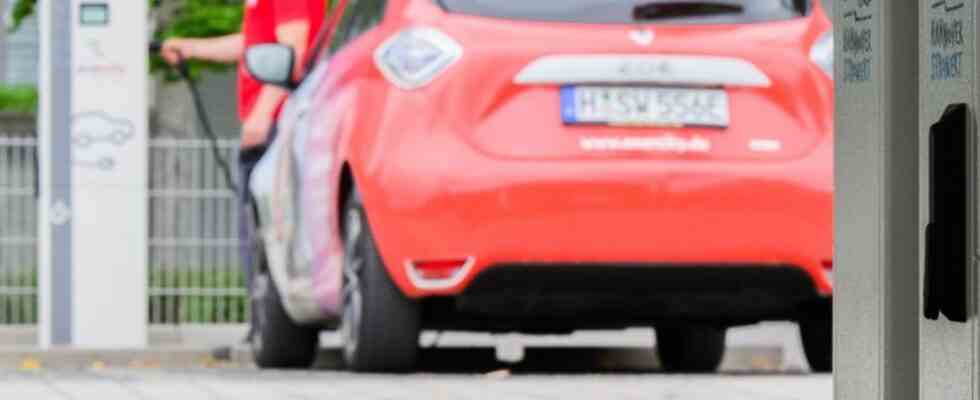traffic and buildings
How the ministries want to catch up on climate protection
Minister of Transport Wissing wants to push ahead with the expansion of charging networks for e-cars. Photo: Julian Stratenschulte/dpa
© dpa-infocom GmbH
Is climate protection falling behind because of an impending gas shortage? The traffic light cannot agree on a common paper. Instead, there are individual programs. One thing in particular causes criticism.
Because too many greenhouse gases are emitted in traffic and buildings, the federal government has to sit in detention on climate protection. Three ministries presented catch-up programs on Wednesday. But at the same time it became clear: the planned major climate package is on hold for the time being. The differences between FDP-led miniseries such as the transport department on the one hand and ministries led by the Greens such as the economics department on the other are too great.
Actually, the intention was to present an immediate climate protection program that would cover all sectors, said Secretary of State for Economic Affairs Patrick Graichen. But: “The discussions in the departmental group are still ongoing.” There were two almost simultaneous appointments in Berlin on Wednesday: Graichen presented the plans for the building sector with Building Minister Klara Geywitz (SPD). Not far from here, Transport Minister Volker Wissing (FDP) presented his program for the transport sector.
“Class target” in climate protection missed
In buildings and in traffic, the permissible CO2 emission levels, which are anchored in the Climate Protection Act, were exceeded in 2021 – “class target missed,” said Geywitz. The responsible ministries had three months to submit their amendments, this deadline expired on Wednesday.
In buildings alone, 152 million tons of CO2 and similar greenhouse gases must be saved by 2030 more than before. According to Graichen, the transport sector is even talking about 270 million tons.
Renovation and climate-friendly heating
In the building sector, the main aim is to close the gap by renovating more houses and establishing a heat supply without fossil fuels. The challenge: not to overburden citizens financially. Because the changeover does not happen overnight, the ministries expect that they will continue to meet the climate targets until at least 2026 – but from 2027 everything will be caught up.
Off for pure gas heaters
As early as 2024, if possible, only new heating systems should be installed that work with at least 65 percent renewable energies. Pure gas heating will then no longer be permitted – a further step in reducing dependence on Russian gas supplies. In addition, higher efficiency standards apply to new buildings. State subsidies should continue to exist for very climate-friendly new buildings, but above all for renovations. Because around three out of four old buildings were built before 1979 and have hardly been renovated to this day.
Funding for district heating and heat pump offensive
District heating is to become a climate-friendly solution for heating in large cities. So far, the grids have been fed mainly from fossil fuels, but this should change with state subsidies. The heat pump is to become the standard solution for detached and semi-detached houses. But so far there is a lack of knowledge about the installation, operation and maintenance of the still quite new technology. Craftsmen should therefore be specifically trained.
Optimization of existing heating systems
Due to the Russian war in Ukraine, energy efficiency is becoming more and more important – especially against the background that Russian gas supplies could be cut off. The settings of existing heating systems should therefore be optimized quickly. It is said that “regulatory” options are also being developed, such as regulations for heating.
Expansion of the charging network for electric cars
A central aspect of Wissing’s immediate program is, in addition to more cycle paths, a nationwide charging network for electric cars – so that the “fear of range” disappears and more people buy e-cars. Wissing reports more money in the household for the expansion of the charging infrastructure. It is assumed that additional budgetary funds of around eight billion euros will be required, it said. But this is not yet united.
What’s next for public transport?
Millions of people have used the 9-euro ticket, but what happens after it expires at the end of August? The Greens in particular want a year-round, inexpensive “climate ticket” for local public transport. But Wissing wants reforms first. A central point for him are simpler tariff structures, on Wednesday he spoke again of a “tariff jungle”. The transport industry has already warned that without more money, the offer would have to be reduced after the 9-euro ticket.
No speed limit – and other points of contention
Wissing again rejected a general speed limit on motorways. There is also no agreement in the government on the reduction of climate-damaging subsidies or the reform of the vehicle tax – that’s what the Greens and many environmental organizations want, so that drivers with less climate-friendly cars have to pay more. The Greens traffic politician Stefan Gelbhaar asked Wissing to make a clear readjustment. The climate alliance Germany criticized that the minister failed across the board.
The dispute in the coalition revolves around one crucial question: does more climate protection require regulatory law, i.e. legal requirements up to and including bans? The FDP firmly rejects this. The conflict is likely to smolder for months, and little movement is expected during the summer break. The climate politician of the opposition Union, Andreas Jung (CDU), therefore demanded: “Now the self-appointed climate chancellor has to do it.” So far, the government of Olaf Scholz (SPD) has no plan to achieve the climate goal.

